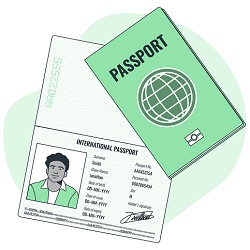
Many students dream of pursuing a master’s degree in USA because it offers both excellent education and strong career prospects. One major benefit is the chance to work during and after their studies, which is especially valuable for international students. It helps ease financial pressure while also building professional experience. Imagine earning a degree from a top university and funding it yourself without needing your own or your family’s money. To make the most of this journey, it is important to understand the job market and related regulations. This blog explores the details of working while studying for a master’s in USA, covering visa options, job opportunities, and strategies for success.
Basics of Working During a Master’s Degree in USA
Financial Considerations
Compared to countries like Germany, Spain, and Norway, the cost of a master’s degree in USA is much higher, with annual tuition ranging from $20,000 (e.g., at Wayne State University) to $60,000 (e.g., at Caltech). When you add student living expenses in the USA, it becomes one of the most expensive places to pursue a master’s degree. Working as a student can help cover living costs, tuition, student loans (if any), and other expenses. Besides the financial support, part-time jobs also help students build professional networks and gain useful skills. Imagine gaining hands-on experience in your field while still studying. It strengthens your academic CV and makes a master’s degree in USA even more appealing for many students.

Working in the USA while pursuing your master’s degree can help you save thousands of dollars. For example, working 20 hours per week at $12 per hour adds up to over $12,000 annually. After graduation, earnings from Optional Practical Training (OPT), i.e., often $50,000+, can further assist international students in covering tuition costs. However, it is important to consider tax obligations. While F-1 students are generally exempt from Social Security and Medicare taxes, they are still required to pay federal and state income taxes. Effective budgeting is essential throughout your master’s studies in USA. Planning your finances carefully ensures that you can manage living expenses, meet academic goals, and avoid unnecessary stress.
F-1 Visa Regulations for International Students
The F-1 visa, which allows for both off-campus and on-campus jobs, is used by most international students pursuing a master’s in USA. During semesters, you can work up to 20 hours a week, and during breaks like the summer, you can work full-time on-campus jobs. For these roles, no further permit is required. Special authorization is needed for off-campus work, such as Optional Practical Training (OPT) or Curricular Practical Training (CPT). These programs offer flexibility by tying jobs to your master’s studies in USA. As an international student, the first step in balancing employment and education is understanding the student visa regulations in the US.
Fair Warning: US visa regulations are complicated, and one mistake could jeopardize your status.

On-Campus Work Opportunities
For both domestic and international students pursuing a master’s degree in USA, on-campus employment is a valuable support. Common and practical roles include working in the dining hall, assisting in the library, or serving as a research assistant. Hourly pay usually ranges from $10 to $15. These jobs are relatively easy to obtain and can be scheduled around your classes. For example, assisting a professor with research can align closely with your field of study. Another option is helping course instructors by tutoring students or assisting with exams. These roles offer a low-stress way to earn money without taking attention away from your academic goals.
Off-Campus Work Opportunities
Curricular Practical Training (CPT) For Internationals
If required by your program, the CPT allows you to work off-campus while pursuing your master’s degree in USA. This includes co-op placements or internships, such as a tech student working as a coder at a company. Both co-ops and internships are forms of work-integrated learning, but they differ in length, structure, and academic credit. Co-ops are usually longer, more formal, and often built into the academic program, while internships tend to be shorter, more flexible, and may not count for academic credit. CPT limits you to 20 hours of work per week during the semester, but full-time work is allowed during breaks. However, using more than 12 months of full-time CPT may affect your options after graduation.
Optional Practical Training (OPT) For Internationals
The OPT is a valuable opportunity for international students with a master’s degree in USA, as it allows them to work in their field of study for up to 12 months after graduation. A major advantage is that students in science, technology, engineering, and mathematics (STEM) fields may qualify for a 24-month extension. Therefore, it provides them a total of up to 36 months of work authorization during and after their master’s degree in USA. You can apply for OPT up to 90 days before completing your degree, and no job offer is required to apply.
To begin working under OPT, you must receive an Employment Authorization Document (EAD) from USCIS. OPT provides a chance to gain real-world experience in the US job market. Unlike CPT, which must be completed before graduation, OPT can be used either before (pre-completion OPT) or after graduation (post-completion OPT), but most students choose to use it after completing their degree.
Federal Work-Study (FWS) Programs For US Citizens
The FWS program is a federally funded financial aid program available to US citizens and permanent residents (PRs). The goal of the program is to assist students with the cost of their master’s studies. In general, the FWS program provides part-time jobs for undergraduate and graduate students with financial need, allowing them to earn money to help pay education expenses. The program encourages community service work and work related to the student’s course of study. It is available to full-time or part-time students. The FWS emphasizes employment in civic education and work related to your course of study whenever possible. You can work both on-campus (usually for your school) and off-campus (usually for private nonprofit organizations or public agencies).

Balancing Work and Study During a Master’s in USA
Time Management
Balancing a master’s degree in USA with employment requires discipline and planning. The biggest challenge is finding enough time, since working 20 hours a week while studying for a master’s degree in USA can be exhausting. Create a routine, for example, attending classes in the morning, working during the day, and studying at night. Use calendars and productivity apps to stay organized and on track. Prioritize your responsibilities by focusing on tasks with approaching deadlines first.
Stress Relief
Since master’s programs in the USA can be intense, it is also important to make time for recreation and rest. Maintaining this balance helps prevent burnout and supports long-term success. Fatigue also exists, particularly in demanding programs. These challenges strengthen your resilience. For stress relief during your studies for a master’s degree in USA, consider practices like meditation or yoga. Just a few minutes a day can significantly lower stress and boost productivity. We recommend exploring meditation apps, platforms, and services to support your well-being.
Ennora Meditation Platform
Ennora is a meditation and brainwave entrainment music platform founded by Peter and Mark in 2009, following a chance meeting at a meditation seminar. Combining Peter’s background in sound engineering and Mark’s passion for brainwave music, they set out to improve the quality of meditation audio by producing professionally engineered tracks in an acoustic studio. Their goal was to address the poor production standards in the field and offer powerful, well-crafted recordings targeting different brain states, including Delta, Theta, Alpha, Beta, and Gamma. Since launching their first collection in 2010, Ennora has expanded its catalogue and now offers Meditation Packs (i.e., collections of multiple tracks) and Individual Tracks (i.e., perfect for your specific needs).
Examples for Ennora’s Meditation Packs
Examples for Ennora’s Individual Tracks
Job Prospects After Your Master’s Degree in USA
After graduation, a master’s degree in USA serves as a powerful launching pad, opening doors to various careers in fields such as engineering, technology, banking, and healthcare. According to the Bureau of Labor Statistics, STEM positions often offer salaries exceeding $80,000 annually. Employers view a master’s degree in USA as a strong indicator of expertise and competence. As mentioned earlier, many graduates use OPT to secure full-time employment, especially by taking advantage of the STEM extension. A significant number later transition to an H-1B visa, a work permit valid for up to six years. If you aim for an academic career pathway (PhD –> postdoc –> faculty position), earning a master’s degree in USA is highly recommended.
Navigating the H-1B Visa Process
The H-1B visa is a popular pathway for international students in the US to transition from study to long-term employment. Designed for specialty occupations that typically require at least a bachelor’s degree, the H-1B visa allows for an initial three-year stay, extendable up to six years, and may lead to permanent residency through a Green Card. Each year, 85,000 H-1B visas are available through a lottery system, i.e., 65,000 for general applicants and an additional 20,000 specifically for master’s or higher degree graduates from a US university. This “master’s cap” gives graduates of US master’s programs a competitive edge in the selection process.
A master’s degree in USA not only improves your H-1B visa chances but also strengthens your job prospects in high-demand fields like STEM, finance, and healthcare. Employers must sponsor H-1B applicants, proving the job requires specialized skills and that the applicant is qualified. The visa also allows spouses and children to reside in the USA and offers a potential path to permanent residency. However, the program faces criticism for potentially lowering wages, favoring foreign workers, and tying employees too tightly to specific employers. Despite these challenges, the H-1B remains a vital mechanism for international talent to build long-term careers in the US, and a master’s degree in USA significantly enhances both eligibility and competitiveness.
Industries Hiring Master’s Graduates
Tech giants like Google, Microsoft, Meta, Amazon, NVIDIA, IBM, Apple, and many others often hire graduates of U.S. master’s programs, especially in fields like data science and artificial intelligence. Similarly, chemical and materials companies such as Wyatt Technology recruit graduates with backgrounds in chemical engineering, chemistry, materials science, and polymer synthesis. Healthcare companies like Pfizer seek master’s graduates in biomedicine, pharmaceuticals, and biomedical engineering. The finance industry also highly values analytics and MBA graduates. These industries appreciate the critical thinking, specialized knowledge, and global perspective gained through a master’s in USA. Exploring current job market trends can help you decide whether to pursue OPT or apply for the H-1B visa.
Last Words
Start early by seeking on-campus employment during your first semester of a master’s program in USA. Connect with professors and alumni, as they often know of job openings. Make your CV stand out by highlighting skills related to your field of study. Focus on companies that are open to sponsoring visas through the OPT or H-1B visa. A master’s degree in USA offers an academic accomplishment and opens doors to career opportunities and personal growth. From campus jobs to post-graduation careers, each step you take builds your future. This guide has outlined job options, visa pathways, and essential tips to help you thrive. Embrace the journey and shape a future you’ll be proud of.
Frequently Asked Questions (FAQs)
Can I work while studying for a master’s degree in USA as an international student?
Yes. If you’re on an F-1 visa, you can work up to 20 hours per week on campus during semesters and full-time during breaks. For off-campus work, you will need special authorization through CPT or OPT, both of which must relate to your field of study.
How does a master’s in USA improve my chances of getting an H-1B visa?
Graduates with a master’s degree in USA benefit from a 20,000-visa exemption under the H-1B lottery, giving them an edge over general applicants. The degree also strengthens job prospects, especially in STEM and specialized fields that require employer sponsorship.
What types of jobs can I get after finishing my master’s degree in USA?
US master’s graduates are in high demand across industries like tech, healthcare, finance, and engineering. Companies such as Google, Pfizer, and JPMorgan Chase frequently hire in fields like AI, data science, biomedical engineering, and analytics, especially through OPT and later, the H-1B visa.









0 Comment